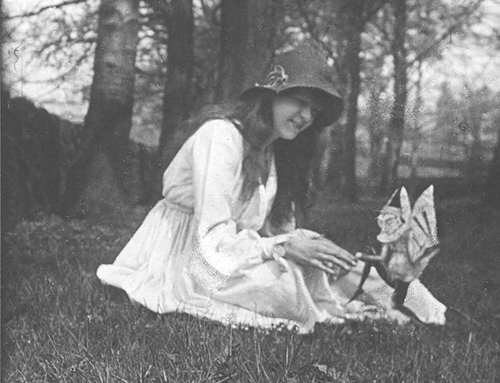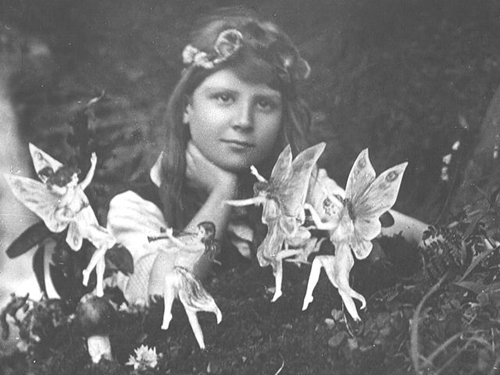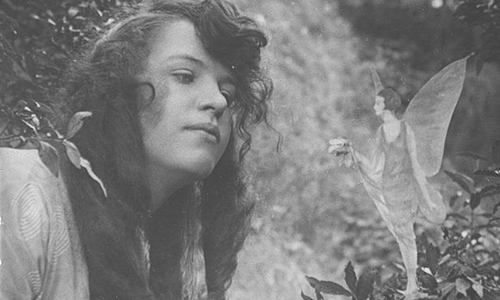The 'fairy' once tricked author Sherlock Holmes
UK "fairies" dance and play with Frances and Elsie in pictures taken by the two girls in July 1917.
Frances Griffiths, 10, from South Africa, came to live with her uncle and aunt's family in England during World War I. Frances and her cousin, Elsie, 16, used to play together in the vast garden at their home. Cottingley village, Bradford.
In July 1917, two girls asked to borrow a camera from Elsie's father, Arthur Wright, telling him that they wanted to take pictures of the "fairies" they had played with all morning. An hour later, the two girls returned the camera to Arthur and he discovered a picture of 4 "fairies" dancing in front of Frances. However, he thinks the image is fake and asks Elsie why "pieces of paper" appear in the image.

When the two girls took a second picture more than a month later, showing Elsie sitting next to a dwarf about 30 cm tall, Arthur still viewed the images as a joke.
However, Elie's mother, Polly Wright, has a strong belief in supernatural phenomena and is attracted to photographs. In 1919, she came to listen to a lecture on spirituality and then showed the pictures to a speaker. Edward Gardner, leader of the Theosophical movement (believing that mankind is going through an evolutionary cycle) paid attention to them and he asked photographer Harold Snelling to check.
Snelling claims these are "real, unedited photos" and "do not have any staged traces such as covers, paper, dark backgrounds, drawings".
"The fact that the two girls are not only able to see fairies but also capture their images could be a sign that the next evolutionary cycle is happening," Gardner said.

The images then quickly spread throughout the community according to the spiritual theory in England called "The Fairies Cottingley". It caught the attention of Arthur Conan Doyle, an English writer famous for his detective novel Sherlock Holmes and strongly believed in spiritual theory.
At that time, Mr. Doyle was ordered by Strand magazine an article about fairies to issue Christmas numbers. He wrote to Elsie and her father to use the photos to illustrate his writing. Arthur was surprised when Mr. Doyle noticed his family and agreed to let him use the image without charge.
Gardner and Doyle also asked Kodak camera company technicians to check and concluded that the photos "showed no signs of being fake". However, they said that this could not be considered as convincing evidence of the existence of "fairies". Meanwhile, another photography company, Ilford, said that "there is some evidence that the photo is fake" but Gardner and Doyle are not interested in this idea.
In late July 1920, Gardner went to see the Wright family and gave them two cameras, asking Elsie and Frances to continue photographing the "fairies". Frances and Elsie insisted that "fairies" would not show themselves if there were others so no one was there to observe the girls taking pictures.
Frances and Elsie took some pictures in August 2020, two of them had fairies. In the first picture, the fairy flies near Frances's nose. In the second photo, a fairy stands on tiptoe on the tree and gives Elsie a flower.
When Gardner received the new photos, he sent a message to express his excitement to Doyle, who was working in Australia. Doyle replied, "I'm glad that in this remote Australia, I still receive your letter and three great photos. When our fairies are admitted, people will be willing to accept the the spiritual image is different than ".

The December 1920 issue of Strand magazine contains Doyle's article and two fairy pictures from 1917 sold out in a few days of publication. However, many expressed doubts because the "fairies" were too similar to the way they were drawn in books. A fairy even had a fashionable hairstyle at that time.
Doyle also used the photographs in 1921 to illustrate the second article on the Strand, narrating the accounts of those who saw the fairies. In 1922, he published a book on this topic.
Gardner last visited Cottingley in August 1921, carrying a camera with the intention of asking Frances and Elsie to take more pictures. However, both said they did not see any fairies and did not take photos. Public interest in the "Cottingley fairy" subsided after 1921. Elsie and Frances married and lived abroad for many years.
When interviewed in September 1976, Elsie and Frances both denied having faked the photos. However, in 1978, the magician James Randi and a team from the Scientific Investigation Committee on the Occult Phenomenon examined photos using computer tricks and concluded that the photos were fake.
In 1983, Elsie and Frances admitted to fake photos. Elsie created "fairies" by copying on a hardcover the pictures of dancing girls from a famous children's book and drawing additional wings. Two people use hairpin to fix.
Doyle died in 1930. Elsie and Frances said in 1985 that they were too ashamed to trick Doyle so they did not admit it soon. "The two country children cheated on a smart man like Conan Doyle. We could only keep quiet."
"I never even thought it was a scam. I and Elsie were just joking and I still don't understand why people are fooled up till now," Frances said.
- People living in the 'safest' places in the world
- The code led the British to hunt down 'golden rabbit treasures' 40 years ago
- The 'glass princess' was always afraid of crumbling in 19th-century Europe
- A series of pictures of anatomy with a dark past in Nazi Germany
- The tribe is willing to help strangers
FIDITOUR TRAVEL COMMUNICATION COMPANY
Representative: Mr. Tran Van Long - Chairman and General Director
Head office: 95B-97-99 Tran Hung Dao, District 1, City. Ho Chi Minh.
Hanoi Branch: 66 Tran Hung Dao, Hoan Kiem District, Hanoi
Phone: 028 730 56789 | Hotline: 19001177